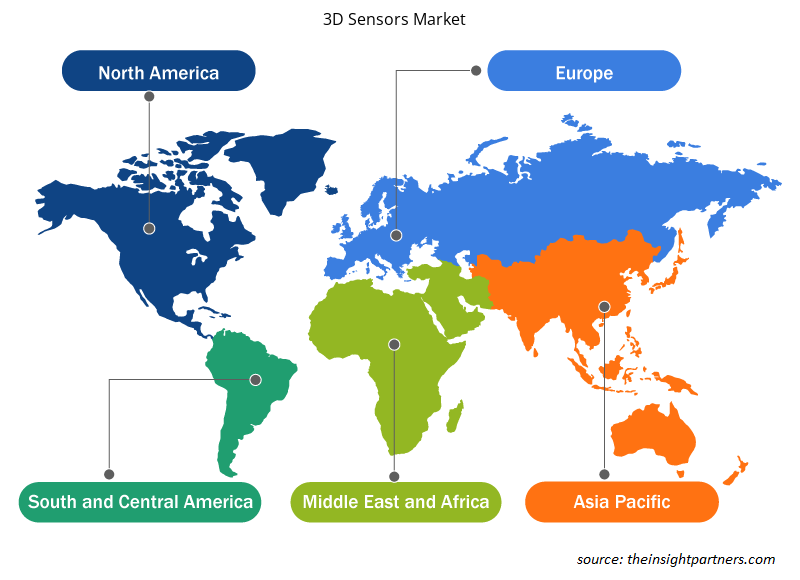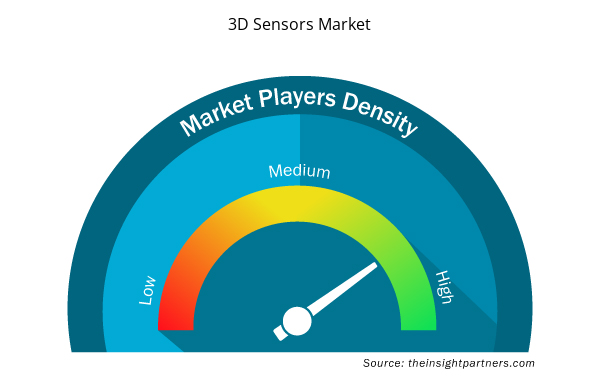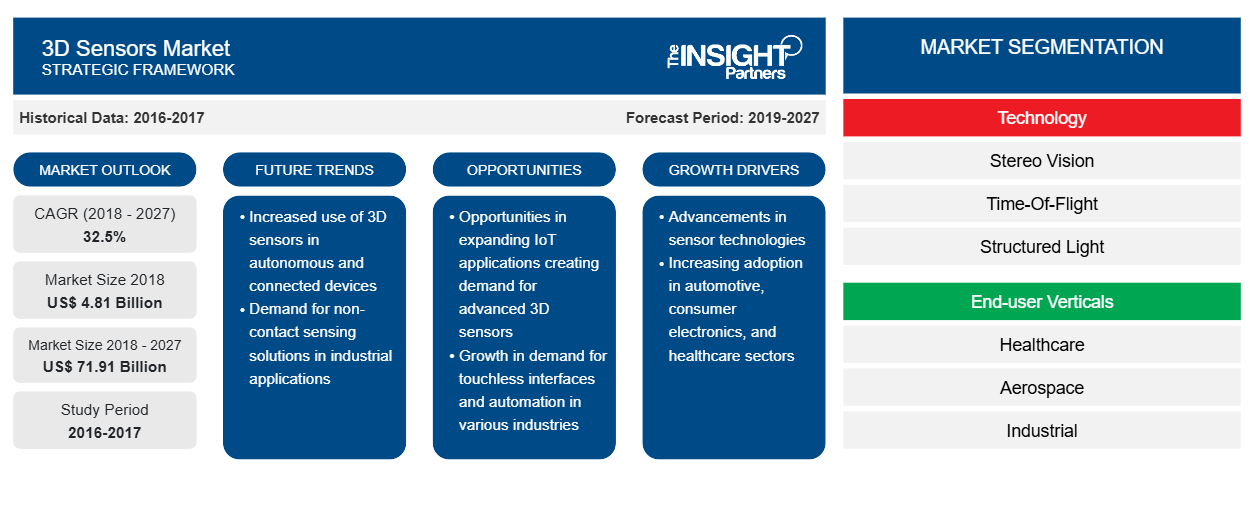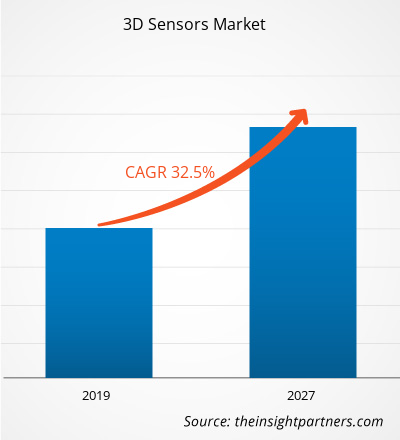[調査レポート] 3Dセンサー市場は2018年に48億570万米ドルと評価され、2027年までに719億1420万米ドルに達すると予測されています。また、2019年から2027年にかけてCAGR 32.5%で成長すると予想されています。
3D センサーは、高フレーム レートで深度画像を提供するアクティブ レンジ センサーを使用します。これらのカメラには、フィールドを照らす IR 光源と、反射された IR 光をキャプチャする CMOS/CCD センサーが装備されています。深度測定は ToF 原理に基づいています。したがって、深度は、IR 信号がオブジェクトまたは観測フィールドに到達して戻ってくるまでの時間に比例します。センサーの各ピクセルで取得された深度測定値を組み合わせて深度画像を生成します。深度画像の高速取得は、ロボット工学、ヒューマン マシン インタラクション、シーン モデリングなど、エンド ユーザーの幅広い分野で非常に役立ちます。残念ながら、現在利用可能な ToF カメラの多くは解像度が低く、センサーによるノイズ、正弦波信号の生成の難しさによる体系的な揺れ誤差、反射率と積分時間に依存する非線形深度オフセット、深度の不均一性 (エッジ) での信号の重ね合わせによって生成されるフライング ピクセルなど、さまざまな測定エラーの影響を受けます。その結果、ToF センサーは正確で精密な深度測定を提供します。現在利用可能なマルチ ToF センサー システムは、占有確率グリッドに頼ったり、さまざまなビューから生成されたポイント クラウドを登録したりして、深度画像を組み合わせて 3D 再構築を構築することに重点を置いています。
ToF 技術は、測距の目的で 10 年以上使用されています。ソナーとレーダーは、特に航空宇宙および航空のエンド ユーザー バーティカルで、ToF 原理の音声信号と無線信号を利用する 2 つの技術です。最近では、電子機器の改善と成熟により、ToF システムに光信号を使用できるようになりました。このようなシステムを使用するエンド ユーザー バーティカルは多数あり、特に産業分野と消費者分野に多く見られます。一般に、最新の ToF センサーで距離を測定するには、パルス変調と連続波 (CW) 変調の 2 つの技術があります。高度な ToF システムでは、複数の変調周波数を組み合わせたマルチ周波数技術が採用されています。
要件に合わせてレポートをカスタマイズする
このレポートの一部、国レベルの分析、Excelデータパックなど、あらゆるレポートを無料でカスタマイズできます。また、スタートアップや大学向けのお得なオファーや割引もご利用いただけます。
- このレポートの主要な市場動向を入手してください。この無料サンプルには、市場動向から見積もりや予測に至るまでのデータ分析が含まれます。
3Dセンサー市場の地域別分析
予測期間を通じて 3D センサー市場に影響を与える地域的な傾向と要因は、Insight Partners のアナリストによって徹底的に説明されています。このセクションでは、北米、ヨーロッパ、アジア太平洋、中東およびアフリカ、南米および中米にわたる 3D センサー市場のセグメントと地理についても説明します。

- 3Dセンサー市場の地域別データを入手
3Dセンサー市場レポートの範囲
| レポート属性 | 詳細 |
|---|---|
| 2018年の市場規模 | 48億1000万米ドル |
| 2027年までの市場規模 | 719億1000万米ドル |
| 世界のCAGR(2018年 - 2027年) | 32.5% |
| 履歴データ | 2016-2017 |
| 予測期間 | 2019-2027 |
| 対象セグメント | テクノロジー別
|
| 対象地域と国 | 北米
|
| 市場リーダーと主要企業プロフィール |
|
3Dセンサー市場のプレーヤー密度:ビジネスダイナミクスへの影響を理解する
3D センサー市場は、消費者の嗜好の変化、技術の進歩、製品の利点に対する認識の高まりなどの要因により、エンドユーザーの需要が高まり、急速に成長しています。需要が高まるにつれて、企業は提供を拡大し、消費者のニーズを満たすために革新し、新たなトレンドを活用し、市場の成長をさらに促進しています。
市場プレーヤー密度とは、特定の市場または業界内で活動している企業または会社の分布を指します。これは、特定の市場スペースに、その市場規模または総市場価値に対してどれだけの競合相手 (市場プレーヤー) が存在するかを示します。
3D センサー市場で事業を展開している主要企業は次のとおりです。
- アムスAG
- インフィニオンテクノロジーズAG
- ifmエレクトロニック有限会社
- メレキシス
- ソニー株式会社
免責事項:上記の企業は、特定の順序でランク付けされていません。

- 3Dセンサー市場のトップキープレーヤーの概要を入手
世界の 3D センサー市場は次のように分類されています。
世界の3Dセンサー市場 – 技術別
- ステレオビジョン
- 飛行時間
- 構造化光
世界の 3D センサー市場 – エンドユーザー別
- 健康管理
- 航空宇宙
- 産業
- 自動車
- 家電
- その他
世界の3Dセンサー市場 – 地域別
北米
- 私たち
- カナダ
- メキシコ
ヨーロッパ
- ドイツ
- フランス
- イタリア
- イギリス
- ロシア
- その他のヨーロッパ
アジア太平洋(APAC)
- 中国
- オーストラリア
- インド
- 日本
- 韓国
- その他のアジア太平洋地域
中東およびアフリカ(MEA)
- サウジアラビア
- 南アフリカ
- アラブ首長国連邦
- その他の中東およびアフリカ
南アメリカ
- アルゼンチン
- ブラジル
- 南米のその他の地域 (SAM)
企業プロフィール
- アムスAG
- インフィニオンテクノロジーズAG
- イフエムエレクトロニック社
- メレキシス
- ソニー株式会社
- STマイクロエレクトロニクスNV
- バスラーAG
- コグネックス株式会社
- オムニビジョンテクノロジーズ株式会社
- LMIテクノロジーズ株式会社
- 過去2年間の分析、基準年、CAGRによる予測(7年間)
- PEST分析とSWOT分析
- 市場規模価値/数量 - 世界、地域、国
- 業界と競争環境
- Excel データセット


- Print Management Software Market
- Cut Flowers Market
- Cosmetic Bioactive Ingredients Market
- Data Center Cooling Market
- Dropshipping Market
- Maritime Analytics Market
- Electronic Shelf Label Market
- Single Pair Ethernet Market
- Single-Use Negative Pressure Wound Therapy Devices Market
- Semiconductor Metrology and Inspection Market

Report Coverage
Revenue forecast, Company Analysis, Industry landscape, Growth factors, and Trends

Segment Covered
This text is related
to segments covered.

Regional Scope
North America, Europe, Asia Pacific, Middle East & Africa, South & Central America

Country Scope
This text is related
to country scope.
よくある質問
Growing demand for the 3D sensor is a major breakthrough in technology. It is a deep sensing technology that enhances the capacity of a camera to recognize faces and objects. Major companies are using this technology for the development of face recognition in mobile phones and also to accelerate the development and commercialization of high resolution, low power active 3D depth-sensing camera system.
The Asia Pacific region led the 3D sensor market with a market share of 48.3%in 2018. The continuous economic growth in developed and developing countries like India and China, coupled with the presence of huge disposable incomes with individuals in countries like Japan and Australia, has facilitated the rapid growth of the automotive industry in this region. The Asia Pacific is one of the world’s rapidly growing consumer electronic with China accounting for maximum 3D sensor device production. The rapid growth in industrialization and urbanization in the economy is positively impacting the growth of the 3D sensor market in the APAC region. Moreover, the market for the 3D sensor is expected to rise with the growth of end-user verticals industries.
The leading type of 3D sensor is the Time-of-Flight (ToF) that has noted to account a CAGR of 41.9%. ToF is regarded as the sensor that has materialized as a promising three-dimensional (3D) sensing technology that can be manufactured economically in a compact size. In ToF, an infrared strobe emits a bright, short pulse, and a custom detector with a very fast shutter speed measures the time that the light travels before hitting an object. However, current state-of-the-art ToF sensors suffer from low spatial resolution due to physical limitations in the fabrication process
Trends and growth analysis reports related to Electronics and Semiconductor : READ MORE..
The List of Companies
- AMS AG
- Infineon Technologies AG
- ifm electronic gmbh
- Melexis
- Sony Corporation
- STMicroelectronics N.V.
- Basler AG
- Cognex Corporation
- OmniVision Technologies, Inc.
- LMI Technologies Inc
The Insight Partners performs research in 4 major stages: Data Collection & Secondary Research, Primary Research, Data Analysis and Data Triangulation & Final Review.
- Data Collection and Secondary Research:
As a market research and consulting firm operating from a decade, we have published and advised several client across the globe. First step for any study will start with an assessment of currently available data and insights from existing reports. Further, historical and current market information is collected from Investor Presentations, Annual Reports, SEC Filings, etc., and other information related to company’s performance and market positioning are gathered from Paid Databases (Factiva, Hoovers, and Reuters) and various other publications available in public domain.
Several associations trade associates, technical forums, institutes, societies and organization are accessed to gain technical as well as market related insights through their publications such as research papers, blogs and press releases related to the studies are referred to get cues about the market. Further, white papers, journals, magazines, and other news articles published in last 3 years are scrutinized and analyzed to understand the current market trends.
- Primary Research:
The primarily interview analysis comprise of data obtained from industry participants interview and answers to survey questions gathered by in-house primary team.
For primary research, interviews are conducted with industry experts/CEOs/Marketing Managers/VPs/Subject Matter Experts from both demand and supply side to get a 360-degree view of the market. The primary team conducts several interviews based on the complexity of the markets to understand the various market trends and dynamics which makes research more credible and precise.
A typical research interview fulfils the following functions:
- Provides first-hand information on the market size, market trends, growth trends, competitive landscape, and outlook
- Validates and strengthens in-house secondary research findings
- Develops the analysis team’s expertise and market understanding
Primary research involves email interactions and telephone interviews for each market, category, segment, and sub-segment across geographies. The participants who typically take part in such a process include, but are not limited to:
- Industry participants: VPs, business development managers, market intelligence managers and national sales managers
- Outside experts: Valuation experts, research analysts and key opinion leaders specializing in the electronics and semiconductor industry.
Below is the breakup of our primary respondents by company, designation, and region:

Once we receive the confirmation from primary research sources or primary respondents, we finalize the base year market estimation and forecast the data as per the macroeconomic and microeconomic factors assessed during data collection.
- Data Analysis:
Once data is validated through both secondary as well as primary respondents, we finalize the market estimations by hypothesis formulation and factor analysis at regional and country level.
- Macro-Economic Factor Analysis:
We analyse macroeconomic indicators such the gross domestic product (GDP), increase in the demand for goods and services across industries, technological advancement, regional economic growth, governmental policies, the influence of COVID-19, PEST analysis, and other aspects. This analysis aids in setting benchmarks for various nations/regions and approximating market splits. Additionally, the general trend of the aforementioned components aid in determining the market's development possibilities.
- Country Level Data:
Various factors that are especially aligned to the country are taken into account to determine the market size for a certain area and country, including the presence of vendors, such as headquarters and offices, the country's GDP, demand patterns, and industry growth. To comprehend the market dynamics for the nation, a number of growth variables, inhibitors, application areas, and current market trends are researched. The aforementioned elements aid in determining the country's overall market's growth potential.
- Company Profile:
The “Table of Contents” is formulated by listing and analyzing more than 25 - 30 companies operating in the market ecosystem across geographies. However, we profile only 10 companies as a standard practice in our syndicate reports. These 10 companies comprise leading, emerging, and regional players. Nonetheless, our analysis is not restricted to the 10 listed companies, we also analyze other companies present in the market to develop a holistic view and understand the prevailing trends. The “Company Profiles” section in the report covers key facts, business description, products & services, financial information, SWOT analysis, and key developments. The financial information presented is extracted from the annual reports and official documents of the publicly listed companies. Upon collecting the information for the sections of respective companies, we verify them via various primary sources and then compile the data in respective company profiles. The company level information helps us in deriving the base number as well as in forecasting the market size.
- Developing Base Number:
Aggregation of sales statistics (2020-2022) and macro-economic factor, and other secondary and primary research insights are utilized to arrive at base number and related market shares for 2022. The data gaps are identified in this step and relevant market data is analyzed, collected from paid primary interviews or databases. On finalizing the base year market size, forecasts are developed on the basis of macro-economic, industry and market growth factors and company level analysis.
- Data Triangulation and Final Review:
The market findings and base year market size calculations are validated from supply as well as demand side. Demand side validations are based on macro-economic factor analysis and benchmarks for respective regions and countries. In case of supply side validations, revenues of major companies are estimated (in case not available) based on industry benchmark, approximate number of employees, product portfolio, and primary interviews revenues are gathered. Further revenue from target product/service segment is assessed to avoid overshooting of market statistics. In case of heavy deviations between supply and demand side values, all thes steps are repeated to achieve synchronization.
We follow an iterative model, wherein we share our research findings with Subject Matter Experts (SME’s) and Key Opinion Leaders (KOLs) until consensus view of the market is not formulated – this model negates any drastic deviation in the opinions of experts. Only validated and universally acceptable research findings are quoted in our reports.
We have important check points that we use to validate our research findings – which we call – data triangulation, where we validate the information, we generate from secondary sources with primary interviews and then we re-validate with our internal data bases and Subject matter experts. This comprehensive model enables us to deliver high quality, reliable data in shortest possible time.


 このレポートの無料サンプルを入手する
このレポートの無料サンプルを入手する